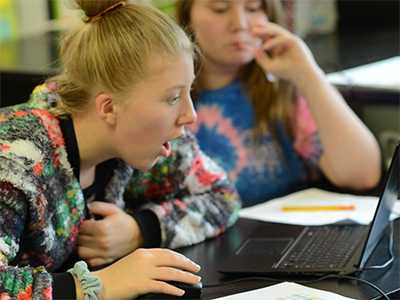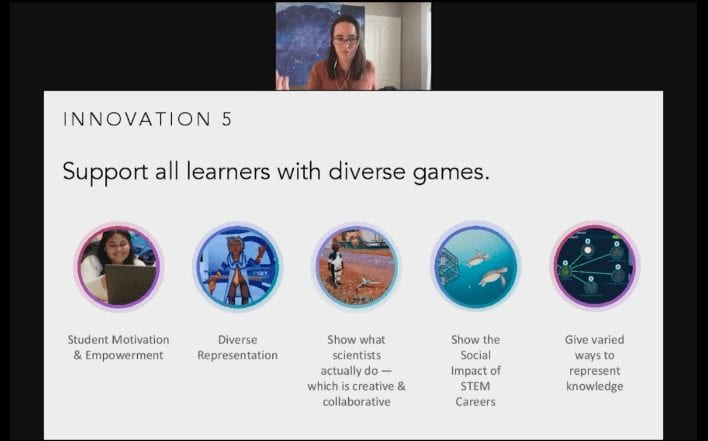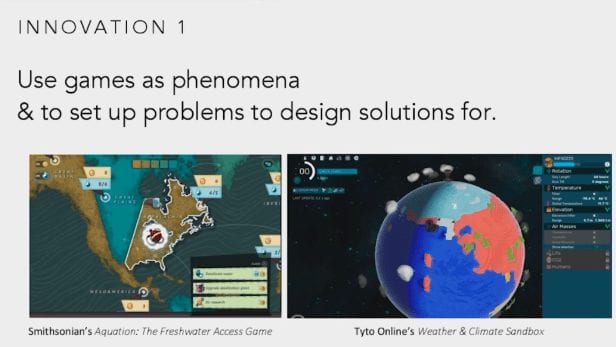Bring Science to Life: The Impact of Video Game Simulations
The situation was bleak: There were just a few plants. The mule deer were hungry. There were no pollinators. Other animals were reproducing. The ecosystem was on the verge of collapse. Those in charge would need to figure out what went wrong. And then make quick decisions to save it.
Good thing this was a simulated game designed to engage students in complex science concepts. They probably won’t feed mule deer in the future, but through a thoughtfully constructed interactive video game, learners can build their science proficiency in engaging and meaningful ways.
In an edWebinar sponsored by Immersed Games, “Supporting Next Generation Science Standards (NGSS) Learning with Video Games,” Lindsey Tropf, M.Ed., founder and CEO of Immersed Games, shared how such games support the NGSS’s approach to propelling learners’ interactions with and applications of science.
NGSS: A Primer
The NGSS are performance standards that delineate what students need to know and be able to do to demonstrate science proficiency. They should understand science concepts and draw on them to answer questions and solve problems as well as connect them to other STEM concepts. Driving NGSS’s advancement are five innovations that highlight this approach.
Three-dimensional learning – The standards are based in three learning dimensions central to science and engineering education:
- Practices, the behaviors of scientists and engineers.
- Crosscutting concepts applied and linked across all science domains.
- Disciplinary core ideas that focus science curricula, instruction, and assessments on the most important aspects of science.
- The integration of engineering and the nature of science into science.
- The connection of science to math and literacy.
Learning progressions – These build complexity across each dimension, moving through grades. There are bands for science and engineering practices, each with endpoints per grade that require the grasp and implementation of specific science skills and knowledge.
Explaining phenomena and designing solutions – This innovation calls for students to move beyond memorization to see the value and usefulness of their learning over time. Anchoring students in a broad topic or phenomenon (looking at evolution via antibiotic resistance, for instance), too complex to address in a single lesson, jumpstarts this exploration. Learners, explained Tropf, use practices to make sense of a topic on their own, and as a result can answer the questions: What are you working on? And why are you working on this?
Phenomena should relate to students’ everyday local experiences or things that are meaningful and important to them and that they can observe. (Next Generation Science Storylines offers an array of phenomenon-based lessons.)
The Game Connection
Tropf explained that demonstrations, technology, or simulations are ideal for framing and involving learners in the study and analysis of phenomena through interactive text and activities. Video games prove to be a useful tool on this front.
Tyto Online is Immersed Games’ collection of interactive simulations that incorporate the NGSS innovations. Each one starts with anchoring phenomena that require students to collect evidence and conduct experiments to solve a problem using evidence-based arguments. The simulations have interactive elements, data sources that respond to ecosystem changes, and tools that provide details about the various species in the virtual environment (how much food an animal needs, survival rates, etc.).
The Tyto Ecology game engages students in a highly interactive simulation that requires the creation of an ecosystem. They must think critically about many factors, focusing on interdependent relationships to decide what to add to a biome to sustain it. In this ecosystem there are several complexities to ponder. For example:
- Mule deer have a 66% chance of finding food. There are 10 mule deer now. But, in 48 weeks, they will reproduce. What will they eat?
- More plants can feed the animals, but they need pollinators. Adding those heightens species competition.
- If the plants aren’t fertilized, then herbivores only have a 34% chance of finding food.
- With more animals, waste and carcasses increase, so decomposers are a must.
As students dive into these problems, they cannot remove elements from the simulation. They must work with them to create equilibrium. In the game, they apply all three learning dimensions:
- Practices: analyzing data, creating environments
- Crosscutting concepts: stability and change, cause and effect
- Disciplinary core ideas: ecosystems
Tropf emphasized that not all games are created equal. “If you find a game, and it is really, really snazzy and cool looking, and maybe has a story,” explained Tropf, “but the students don’t really do anything but click ‘next’ and read the story, that’s not going to be a great NGSS opportunity.” (She noted Science Game Center as a source of quality science games.)
Students learn science by doing science. They explore, examine, and explain how and why phenomena occur and design solutions to problems. Video games further their understanding of science content and develop skills, from collaboration to data analysis, that will benefit them in their educational and career experiences.
This edWebinar was sponsored by Immersed Games.
This article was modified and published by EdScoop.
About the Presenter
Lindsey Tropf, M.Ed. is the founder & CEO of Immersed Games. Before founding Immersed Games, she was a doctoral candidate at the University of Florida in School Psychology, with a specialization in program evaluation and a minor in research and evaluation methodology, and expertise in data-based decision making. With Immersed Games, she’s led the company from founding to development of two titles, growth of their game-based learning curriculum, through the Intel Education Accelerator, obtaining grants from the National Science Foundation and Department of Education, and implementing their product into schools and districts.
About the Host
Joyce Whitby is the president of Innovations4Education. She is a lifelong educator who spent over ten years teaching graduate-level courses in educational technology at Long Island University, where, in 1984, she developed the T.E.A.M. program (Telecommunications, Education, and Multimedia). Since then, Joyce has been in the business of educational technology with key roles in professional development, marketing, and sales leadership. Most notably she has developed strategic sales initiatives targeting complex and urban environments for several organizations including WICAT Systems, Jostens Learning, Scientific Learning, Apple Computer, Monarch Teaching Technologies (makers of VizZle, an app for students with autism), and the education group of West Corporation (SchoolMessenger solutions). She has been an active member of SIIA for over 15 years.
Join the Community
Teaching Next Generation Scientists is a free professional learning community on edWeb.net that provides educators and curriculum leaders with a place to collaborate on improving classroom practices for teaching PreK-12 science.
Our mission is to empower learners to engage in deeper learning, solving authentic problems as they learn science. Using our game, Tyto Online, helps teachers deliver hands-on science learning that develops scientific problem solving and is designed for the Next Generation Science Standards.






Comments are closed.